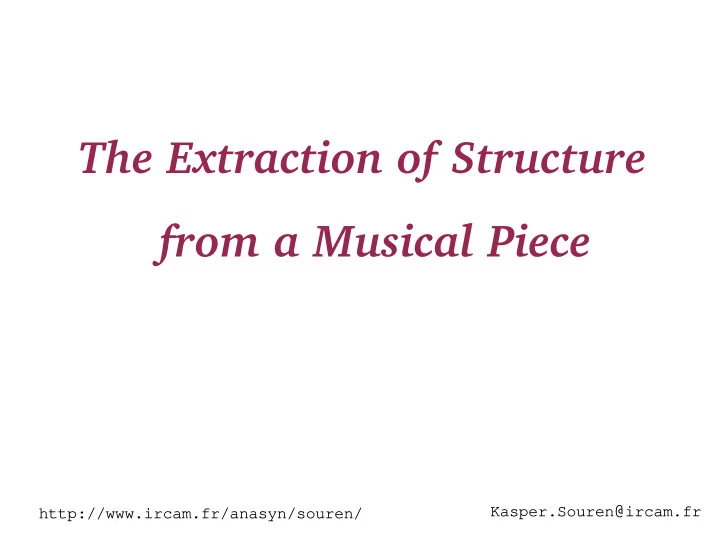

The Extraction of Structure from a Musical Piece Kasper.Souren @ ircam.fr http://www.ircam.fr/anasyn/souren/
Musical Structure related to human perception rather from the listener's standpoint than from the composer's standpoint
Finding structure audio, no MIDI or symbolic information audio descriptors not (yet) limited to one style looking for similarity and borders
Most significant spectrum variations raw audio (11025 Hz) musical piece (ogg, wav, mp3) log FFT power spectrogram log FFT spectrum band variation information EOF principal components most significant spectrum band variations
Most significant spectrum variations frequency spectrogram 100 feature vectors per second PC of “log FFT” of frames from every band most significant spectrum band variations time about 1 feature vector per second
EOF based on SVD Empirical Orthogonal Functions, based on Singular Value Decomposition popular in climate research type of Principal Component Analysis useful for reducing number of dimensions while explaining large part of variance
Similarity matrix J. Foote, 1999 1) the audio descriptors are N-dimensional space 2) calculate mutual distances: distance matrix 3) rescale: similarity matrix
Similarity matrix most significant spectrum variations time Similarity Matrix Chardonnay Says by Nood/Banana time time
Finding similar parts step 1: calculate lag matrix similarity matrix lag matrix ` time time time delay time
Finding similar parts step 2: apply 2D FIR filter to blur lag matrix blurred lag matrix time time delay time delay time
Finding similar parts step 3: find vertical local maxima its local maxima blurred lag matrix (values from non-blurred matrix) time time delay time delay time
Finding similar parts step 4: post-processing 0) forget first column (diagonal of similarity matrix) 1) localize sufficiently long contiguous parts 2) remove overlaps 3) remove diagonal parts local maxima similar parts
Finding borders step 1: convolution, kernels of different sizes filtered matrices similarity matrix
Finding borders step 2: diagonals => columns diagonals of filtered matrices filtered matrices time kernel size
Finding borders step 3: find local maxima in columns diagonals of filtered matrices local maxima time
Finding borders step 4: post-processing 1) localize contiguous parts 2) sum their values 3) throw away positions with too low values time 4) refine the positions using the spectrogram
Structural Information Theory formal calculus for Gestalt laws focus on visual patterns experimented with Genetic Programming problem: need for much higher description, musical objects, thus source seperation, classification, ...
Framework for Audio Analysis functionality interesting for audio and music research integrating research could be fruitful finding musical structure audio signal separation sound classification ...
Python scripting language, interpreted object-oriented flexible, extensible, easy to embed modular free software (BSD style license)
FfAA modes Scientific analysis environment stand-alone application: QtFfAA GUI + command line, object viewer, visualisation Embeddable in free audio software for audio editors and recorders for music players, DJ tools
FfAA right now versatile interface MDI GUI (PyQt) commandline (IPython) load and analyse sound files database visualisation easily extensible
The Extraction of Structure from a Musical Piece Kasper.Souren @ ircam.fr http://www.ircam.fr/anasyn/souren/
Recommend
More recommend